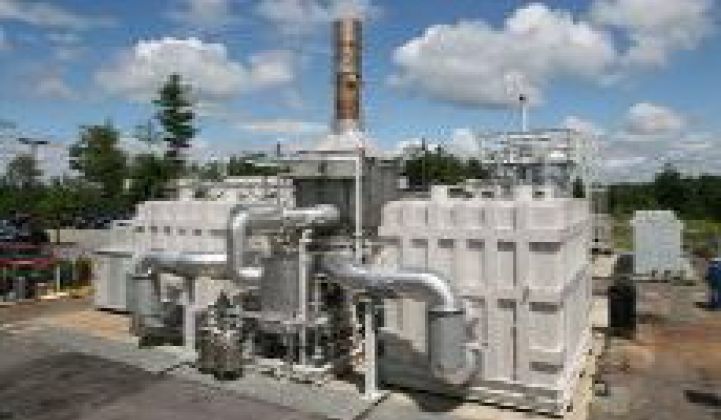I have gotten an enormous amount of mileage from this list. It is the list of profitable fuel cell firms, and it goes like this:
1.
2.
3.
We may soon have an entry for this perennially empty list. In fact, FuelCell Energy (Nasdaq:FCEL) has had two consecutive quarters with positive gross margins ($0.4 million in the fourth quarter), revenue that beat expectations, and a strong backlog.
FuelCell Energy builds molten carbonate stationary fuel cell power plants deployed at wastewater treatment plants, schools, pump stations, and sites that need low-emission baseload distributed generation.
Going by headlines, one would think that Bloom Energy invented fuel cells and pioneered their commercialization. In reality, fuel cells were invented in the 1800s and there is a large crowd of fuel cell firms going after the same stationary fuel cell market as FCE. They have in common a strong technological focus, a dependence on subsidies, and a tendency to lose enormous sums of money. Vendors in this sector include Bloom, Acal Energy, Ceres Power, UTC, ClearEdge Power, and Idatech.
FuelCell Energy's largest customer is POSCO Power, an independent power producer based in South Korea. But FuelCell Energy has also sold two 1.4-megawatt power plants to California utility PG&E and has three new plants in Southern California.
The firm looks to get to profitability at a yearly shipment rate of 85 megawatts to 90 megawatts. Production levels are currently at 56 megawatts annually compared to production of 22 megawatts in 2010. The company has a market cap of $117 million.
On the most recent year-end earnings call Chip Bottone, CEO and Mike Bishop, SVP and CFO, noted that:
- The firm had record revenues and generated gross profits during the third and fourth quarters, its "first since commercializing its products."
- Total revenues for the fourth quarter of 2011 were $34.7 million, compared to $19.7 million in the same period last year.
- The company's backlog totaled $210 million as of October 31, 2011, compared to $154 million at the end of the prior year.
- For the fiscal year, the company reported total revenue of $122.6 million, up 76 percent compared to total revenue of $69.8 million in 2010.
Net loss for 2010 was $58.9 million. Net loss for this fiscal year was $40.6 million.
During the last few months, FCE has installed power plants at eight locations in the U.S. POSCO installed two DFC power plants in South Korea, totaling 11.2 megawatts. The firm also announced a partnership with Abengoa to develop fuel cells powered by biofuels.
On the regulatory front, FuelCell Energy noted that the California PUC updated the SGIP program, and codified a combined heat and power feed-in tariff program. The CPUC also instituted a feed-in tariff for CHP applications, geared to power plants up to 20 megawatts in size. Under the FIT, excess electricity not used on site can be sold to the grid at the market price referent, as long as the heat is used on site.
Sanjay Shrestha of Lazard Capital rates the firm a "buy" and says the firm is "at an inflection point toward its path to profitability."
Declining prices, government incentives, demand for cleaner power and improving technology have begun to revive the fuel cell industry. In the U.S., fuel cell incentives include a federal tax credit for 30 percent of the cost of a fuel cell. California kicks in another $2.50 per watt. The U.K. has a feed-in tariff for micro CHP, which readily applies to fuel cells.
Without a doubt, there are some applications for which fuel cells make perfect sense, such as premium power for the military, use at remote sites, the construction industry, travel, etc. But fuel cell firms have learned the hard way that they must focus on the requirements of specifically addressed niche markets. And they must continue to scrub costs out of their systems.
Nevertheless, FuelCell Energy looks like the leading candidate to populate that currently barren profitability list.



